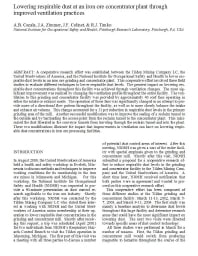Mining Publication: Lowering Respirable Dust at an Iron Ore Concentrator Plant Through Improved Ventilation Practices
Original creation date: June 2006
Authors: AB Cecala, JA Zimmer, JF Colinet, RJ Timko
NIOSHTIC2 Number: 20030310
In: Mutmansky JM, Ramani RV. eds. Proceedings of the 11th U.S./North American Mine Ventilation Symposium (University Park, PA, June 5-7, 2006). London, UK: Taylor & Francis Group; :189-196
A cooperative research effort was established between Tilden Mining Co. LC, the United Steelworkers of America, and NIOSH to lower respirable dust levels in an iron ore grinding and concentrator plant. This cooperative effort involved three field studies to evaluate different techniques to lower respirable dust levels. The greatest impact on lowering respirable dust concentrations throughout this facility was achieved through ventilation changes. The most significant improvement was realized by changing the ventilation profile throughout the entire facility. The ventilation to this grinding and concentrator facility was provided by approximately 40 roof fans operating in either the intake or exhaust mode. The operation of these fans was significantly changed in an attempt to provide more of a directional flow pattern throughout the facility, as well as to more closely balance the intake and exhaust air volume. This change accounted for a 31% reduction in respirable dust levels in the primary grinding area of the mill. Another successful modification was to improve the sealing of a reclaim tunnel to the outside and to barricade the access point from the reclaim tunnel to the concentrator plant. This minimized the dust liberated in the conveyor tunnels from traveling through the reclaim tunnel and into the plant. These two modifications illustrate the impact that improvements in ventilation can have on lowering respirable dust concentrations in iron ore processing facilities.

NIOSHTIC2 Number: 20030310
In: Mutmansky JM, Ramani RV. eds. Proceedings of the 11th U.S./North American Mine Ventilation Symposium (University Park, PA, June 5-7, 2006). London, UK: Taylor & Francis Group; :189-196